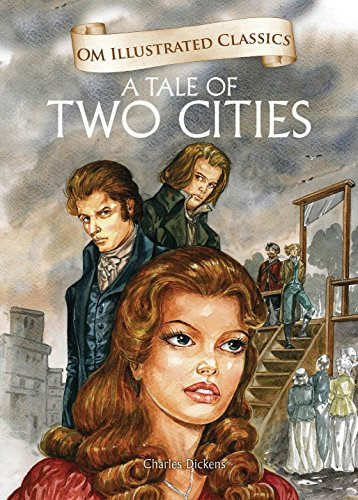What role does Madame Defarge play in the novel A Tale of Two Cities
What is the role of Madame Defarge in A Tale of Two Cities?, Madame Defarge in A Tale of Two Cities, Madame Defarge Character Analysis in A Tale of Two Cities, The main character in A Tale of Two
Cities, Madame Therese Defarge, is presented as an apparently austere and
unforgiving figure. Wed to Ernest Defarge, a revolutionary Parisian wine
merchant, Madame Defarge soon comes to represent the downtrodden seeking
justice. She plays more than just an opponent; she represents the oppressed
people's collective rage and desire for retribution. What role does Madame Defarge play in the novel A Tale of Two Cities
What role does Madame Defarge play in the novel A Tale of Two Cities-The novel A Tale of Two Cities by
Charles Dickens explores themes of resurrection, sacrifice, and the
irresistible pull of fate while taking place against the turbulent backdrop of
the French Revolution. Madame Defarge shows up as a fascinating and complex
figure in this complex narrative tapestry, and she plays a crucial part in the
happenings. Madame Defarge serves as a catalyst for the novel's main themes,
symbolizing both the sweeping force of revolutionary zeal and the personal
grudges of the oppressed with her nuanced blend of ruthlessness, vengeance, and
symbolism.
BUY PDF - IGNOU BEGC-110 SOLVED ASSIGNMENT 2023-24
1. Madame Defarge as a Catalyst of
Revenge:
At the heart of Madame Defarge's
role is her function as a catalyst for revenge. Her outward calmness belies the
burning intensity of her desire for retribution against the aristocracy,
particularly the Evrémonde family. The symbolically knitted registry she keeps
becomes a chilling testament to her relentless pursuit of justice, or rather,
revenge, as she methodically records the names of those she deems guilty.
- Read More : The novel A Tale of Two Cities Summary
What role does Madame Defarge play in the novel A Tale of Two Cities-Madame Defarge's personal vendetta
is fueled by the Evrémondes' cruel and oppressive actions, including the
heinous acts committed against her family. Her quest for revenge is not merely
an individual pursuit; it mirrors the broader sentiment of the oppressed masses
seeking to overthrow the oppressive aristocracy. Madame Defarge encapsulates
the vengeful spirit that permeates the revolutionary atmosphere of the novel.
2. Symbolism in Madame Defarge's
Knitting:
Madame Defarge's incessant knitting
is one of her most distinctive character traits. However, in the story, this
seemingly little deed assumes a tremendous symbolic meaning. The
revolutionaries use Madame Defarge's knitting as a coded language, a covert and
subversive form of communication. According to the revolutionaries, every
thread stands for a life that is about to be taken, a destiny sealed in the
relentless march toward justice.
What role does Madame Defarge play in the novel A Tale of Two Cities-The binding and unavoidable aspect
of fate is also symbolized by the knitting. With her painstaking knitting,
Madame Defarge weaves the fates of the oppressors and the downtrodden, becoming
a symbol of the unwavering might of the revolution. The sound of her needles
clicking parallels the unrelenting pursuit of justice, propelling the book
towards its unavoidable and sorrowful denouement.
3. Madame Defarge as a Symbol of
Revolutionary Wrath:
Beyond her individual vendetta,
Madame Defarge embodies the broader revolutionary wrath that engulfs France.
Her character represents the collective anger of the oppressed masses seeking
to dismantle the oppressive aristocracy. Dickens uses Madame Defarge to depict
the harsh reality that vengeance, once unleashed, can become an all-consuming
force, indiscriminate in its consequences.
Also Read-
- The Character Sketch Of Susan Henchard In The Mayor Of Casterbridge
- Write A Note On Lamb’s Characteristic Humor And Pathos With Reference To The Essay Your Studied
- What Major Aspects Can Be Attributed For Mary Shelley To Become A Great Writer
What role does Madame Defarge play in the novel A Tale of Two Cities-Madame Defarge's actions and
demeanor reflect the dehumanizing impact of prolonged oppression. She is
portrayed as unyielding, with a heart seemingly hardened by the atrocities
committed against her family and the larger populace. In her pursuit of
justice, she becomes an emblematic figure, illustrating the dangers of
unchecked revolutionary fervor and the potential for vengeance to spiral into a
force beyond human control.
4. Madame Defarge in Contrast to Lucie
Manette:
Madame Defarge's character gains
additional depth when juxtaposed with Lucie Manette, a central figure
representing the light and compassion in the novel. While Lucie embodies the
capacity for forgiveness and redemption, Madame Defarge serves as a stark contrast—a
symbol of the unrestrained desire for revenge. Their characters highlight the
dichotomy of responses to oppression, with Lucie representing hope and Madame
Defarge representing the destructive power of vengeance.
BUY PDF & Book
WhatsApp - 8130208920
This dichotomy is particularly evident
in their attitudes toward Charles Darnay, who is linked to both families.
Lucie's capacity for forgiveness and compassion contrasts sharply with Madame
Defarge's unrelenting determination to see Darnay face the consequences of his
family's actions. The dynamic between these two characters enriches the novel's
exploration of the complexities of justice, mercy, and the human response to
trauma.
5. Madame Defarge's Role in the Tragedy
of Sydney Carton:
Madame Defarge's role extends
beyond the vendetta against the Evrémondes, intersecting with the tragic fate
of Sydney Carton. The relentless pursuit of retribution embodied by Madame
Defarge contributes to the tragic course of events that lead to Carton's
ultimate sacrifice. Carton, in his self-destructive quest for meaning and
purpose, becomes entangled in the broader narrative of revolutionary justice
represented by Madame Defarge.
The convergence of Madame Defarge's
vendetta and Carton's sacrificial act underscores the inextricable link between
personal vendettas and the broader forces of historical change. Madame Defarge
becomes a catalyst for the novel's tragic resolution, as the personal and the
political collide in a climax that reverberates with the echoes of the French
Revolution.
6. Madame Defarge's Legacy:
Madame Defarge leaves a lasting
imprint on the narrative, her character serving as a symbol of the
revolutionary spirit and the complexities inherent in the pursuit of justice.
Her legacy extends beyond the confines of the novel, resonating as a cautionary
tale about the consequences of unchecked vengeance and the dehumanizing impact
of prolonged oppression.
The symbolic knitting, Madame
Defarge's steely determination, and her role in the unfolding tragedy
collectively contribute to her enduring significance. Dickens, through Madame
Defarge, invites readers to grapple with the moral ambiguities of revolution,
justice, and the human capacity for both compassion and ruthlessness.
Conclusion
Madame Defarge is a powerful and
mysterious figure in A Tale of Two Cities, an important part of the book's
investigation of justice, retribution, and the turbulent context of the French
Revolution. Madame Defarge represents the individual grudges of the downtrodden
masses, especially against the nobility, acting as a catalyst for retaliation.
Her unwavering quest for justice, exemplified by her symbolic knitting, turns
into a terrifying metaphor for the revolutionary fever sweeping through France.
Madame Defarge's character is not
confined to individual vendettas; she serves as a symbol of revolutionary
wrath, embodying the collective anger and desire for retribution against the
oppressive aristocracy. Her stoic demeanor, unyielding determination, and
symbolic activities contribute to the broader themes of the novel, illustrating
the dehumanizing impact of prolonged oppression and the potential dangers of
unchecked revolutionary fervor.
The juxtaposition of Madame Defarge
with characters like Lucie Manette and her role in the tragic fate of Sydney
Carton adds layers of complexity to her character. Through these interactions,
Dickens explores the dichotomy of responses to oppression, the complexities of
justice and mercy, and the interconnectedness of personal vendettas with the
broader forces of historical change.
Madame Defarge's legacy extends
beyond the pages of the novel, serving as a cautionary tale about the
consequences of vengeance and the human capacity for both compassion and
ruthlessness. Dickens, through the character of Madame Defarge, invites readers
to reflect on the moral ambiguities of revolution, the complexities of justice,
and the indelible impact of historical upheaval on individuals and society.
IMPORTANT QUESTIONS
Q 1. What role does Madame Defarge play in "A Tale of Two
Cities"?
Madame Defarge plays a pivotal role
in "A Tale of Two Cities" as a catalyst of revenge and a symbol of
revolutionary wrath. Her character represents the personal vendettas of the
oppressed masses, particularly against the aristocracy. Madame Defarge's relentless
pursuit of justice, manifested through her symbolic knitting, contributes to
the broader exploration of revenge, justice, and the French Revolution.
Q 2. How does Madame Defarge symbolize revolutionary fervor?
Madame Defarge symbolizes
revolutionary fervor through her unyielding determination, stoic demeanor, and
symbolic activities. Her knitting becomes a chilling representation of the
sweeping force of the revolution, with each stitch representing a life to be
taken. Madame Defarge embodies the collective anger and desire for retribution
against the oppressive aristocracy.
Q 3. How does Madame Defarge contribute to the exploration of
justice and
revenge?
Madame Defarge contributes to the
exploration of justice and revenge by embodying the personal vendettas of the
oppressed masses. Her relentless pursuit of justice against the aristocracy
reflects the broader themes of revenge and the dehumanizing impact of prolonged
oppression. Madame Defarge's character serves as a cautionary tale about the
consequences of unchecked revolutionary fervor.
Q 4. What contrasts does Madame Defarge present in the novel?
Madame Defarge presents contrasts
in the novel, particularly in juxtaposition with characters like Lucie Manette.
While Lucie embodies hope, forgiveness, and compassion, Madame Defarge
symbolizes the destructive power of vengeance. This dichotomy highlights the
complexities of responses to oppression and adds depth to the exploration of
justice, mercy, and the human capacity for both compassion and ruthlessness.
Q 5. How does Madame Defarge contribute to the tragic fate of
Sydney Carton?
Madame Defarge's role extends to
the tragic fate of Sydney Carton, as her relentless pursuit of revenge
contributes to the unfolding events. The convergence of Madame Defarge's
vendetta and Carton's sacrificial act underscores the inextricable link between
personal vendettas and the broader forces of historical change. Madame Defarge
becomes a catalyst for the novel's tragic resolution.








0 comments:
Note: Only a member of this blog may post a comment.